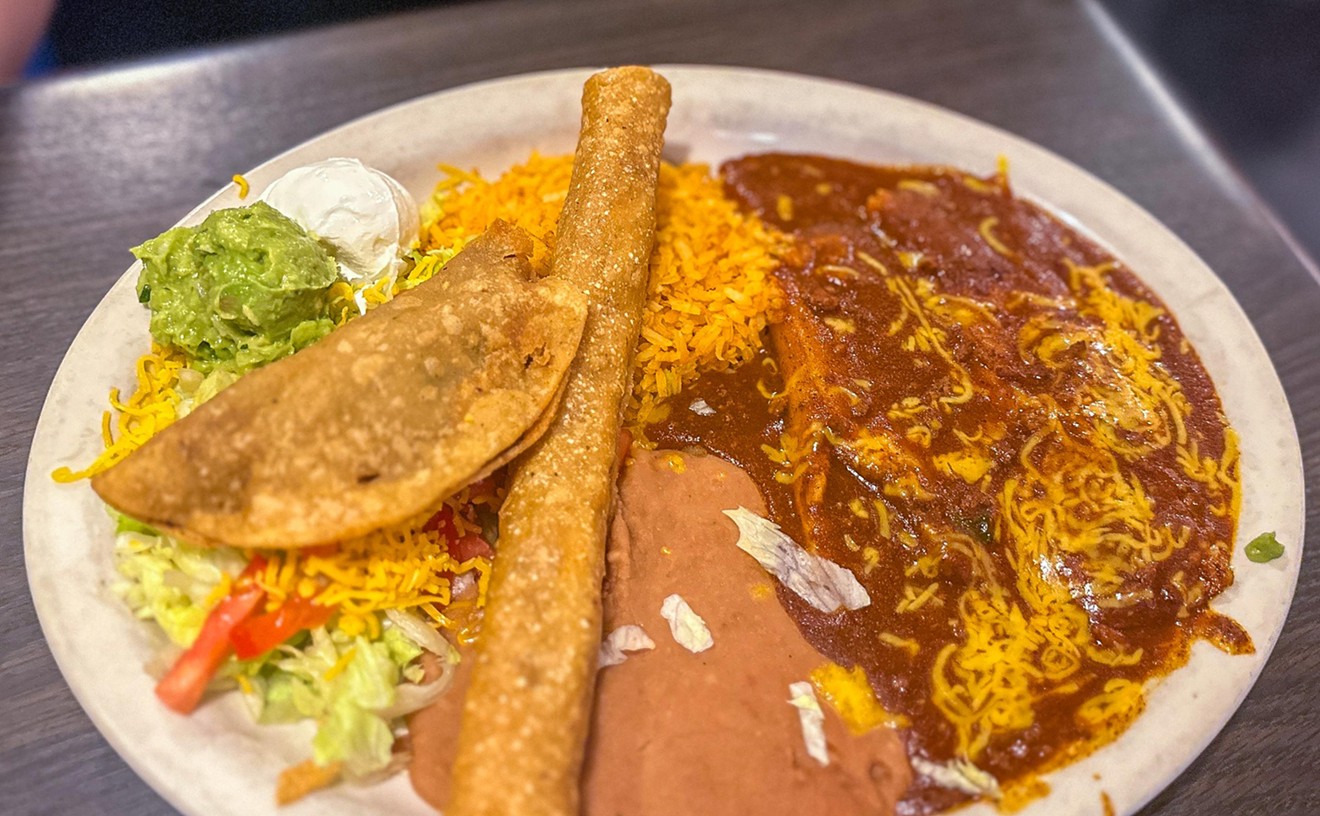Poutine. Ramen. Samosas. Dallas is crazy about foreign foods, from the trendy bowl of pho to the old standby of tacos al pastor. But our city has such a diverse collection of nationalities that there are dishes, and even whole cuisines, you’ve probably never heard of. Here are some of our favorites, along with restaurants where you can find them.
1. Colombia: ajiaco (Casa Vieja in Carrollton). Ajiaco is Colombia’s visionary reinvention of chicken soup. Add as many different kinds of potato as you can find, and then instead of watery broth, create a thick, creamy soup of root vegetables, native herbs and corn. Serve with heavy cream and capers in bowls on the side, so the customer can find the balance that suits them best. It’s a hearty, addicting soup that cures all ailments, physical or spiritual.
Casa Vieja serves ajiaco only on the last Sunday of every month, and for regular customers, it’s a pilgrimage. Our waitress looked around the table and asked, “Ajiaco for everyone?” Yes. Ajiaco for everyone.
2. Turkey: Turkish pizza (Café Istanbul or lunch service at Souk). Turkey has two kinds of “pizza.” Lahmacun (la-MA-gen) is a thin-crust version, usually topped with ground lamb, finely chopped onions and spices. If you want, you can roll it up and eat it like a taco, a popular technique among Turkish-Americans, although this author’s Turkish mom says nobody did the taco thing in Istanbul when she was a kid.
The other kind of pizza is pide, which is basically a canoe of dough filled with cheese and, optionally, spicy sausage links. Who could say no to that?
3. Laos: larb (Nalinh Market in Irving). Laos has the misfortune of being stuck between three of the world’s most famous cuisines: Thai, Vietnamese and Chinese. But if you’re thinking, “Hey, I bet combining all those styles would taste pretty good,” head over to Nalinh Market and find out.
Truth be told, larb does taste like a collision of different cultures. Choose a protein — beef, chicken, fish or (if it’s on special) duck — and the chef will throw it together with cilantro, mint, ginger and chili peppers. If the larb is too spicy, build your own lettuce wrap or add a bunch of rice. If it’s not spicy enough, squirt in some Sriracha, although Nalinh Market is one of those joints that is very, very serious about the word "spicy."
4. Singapore: fried kueh tiao (Lion City in Plano). The national cheap-eats dish of Singapore is fried kueh tiao, and they know what they’re doing. Kueh tiao is a giant pile of greasy wok-fried noodles, flat and wide and drenched in umami flavor. At Lion City they top the dish off with scallops, clams and shrimp, or you can opt for a vegetable medley if you’re pretending to be healthy. If you’re actually being healthy, you’re not ordering kueh tiao. Sorry about that. Maybe reconsider your life choices.
5.Vietnam: caramelized clay pots (Bistro B or 45 Mint). If there’s one food group we Texans love more than any other, it's meat, preferably served sizzling. And the Vietnamese excel at this, with a clay pot cooking process that caramelizes the edges of the meat as it cooks in fish sauce, seasonings and selected veggies. At either 45 Mint or Bistro B, you can try the pork (thit kho to) or fish (ca kho to) versions. Both are irresistible.
6. Japan: okonomiyaki (Tei An). This is better known in America by its white-people name, That Thing With the Creepy Stuff on Top That Wiggles. Don’t worry. The creepy stuff that’s wiggling on top is not super gross. It’s dried, super-thin flakes of smoked fish, usually tuna. Because the smoked fish flakes are so tiny, the sizzling heat of the food underneath causes them to wiggle around.
As for okonomiyaki, it’s basically a giant savory pancake, made with ingredients like scallions, cabbage, pork belly, fish and/or octopus. Okonomiyaki sauce is a Japanese variation of Worcestershire, made specifically for these pancakes. As soon as you dig into this hot, substantial comfort food, you’ll stop thinking of the dancing fish flakes as weird, and decide they’re kinda cute.
7. India: pretty much every dish at Taj Chaat in Irving. Chaat is the Indian term for street snacks, and given the sheer size of the subcontinent, we’re not surprised there are so many unfamiliar dishes here. Take dahi bhalle (deep fried lentil fritters soaked in yogurt) or pakoras (basically mixed-vegetable latkes) or uthappam (thin lentil-dough pizza). If you’re still hungry, you can order a dosa, a crepe filled with so much spiced filling that even a single order can be a Man vs. Food challenge.
If you want to stay out of your comfort zone all dinner long, Taj Chaat is great, because India also has a multitude of sweet desserts that are completely unfamiliar to us Americans. They’re also usually completely delicious.
8. Turkey: hunkar begendi (Café Istanbul). Yeah, OK, Turkey is on the list twice, but you know what? It’s one of the world’s most underrated cuisines. Also, the author of this article is Turkish, and he is biased, so shut up.
Roast some eggplant until it’s smoky and nearly burnt. Mash it up with garlic and cheese. Top it with grilled or slow-cooked lamb and a hearty tomato stew. The result: the ultimate comfort food, known in Turkey as the Sultan’s Delight. You could probably order it that way, but if you want to work on your Turkish pronunciation, say “HOON-care BAY-end-ih.” The g is silent.
9. Germany: kassler ripchen (Jörg’s Cafe Vienna in Plano). It’s just a pork chop, right? Yes and no. Kassler ripchen is smoked, or “double-smoked” at Jörg’s, then brined and cooked as minimally as possible. Jörg’s has a big spread of foods that are neither pretzels nor Wienerschnitzels, and if you can will yourself not to order one of those, you’ll be rewarded.
10. Half the planet: halva (several Middle Eastern, Indian and Polish groceries). Time for dessert! Halva is also spelled helva, chalwa, halawa and about 10 other ways, because it’s consumed in the Middle East, north Africa, the Balkans, India, Pakistan, Poland, Russia, Argentina and various Jewish communities around the globe.
What is halva? It’s basically a mixture of tahini (sesame paste) and sugary syrup, produced in loaves so you can eat a crumbly, sugary slice. It's a dessert with a nice sweet kick that's also marginally healthy. (There's also a sugar-free version for those who have lost the joy in life.) You can get halva plain, but the favorite of most Middle Easterners has whole pistachios mixed in. Some groceries also stock halva with cocoa powder or chocolate.
[
{
"name": "Air - MediumRectangle - Inline Content - Mobile Display Size",
"component": "18855504",
"insertPoint": "2",
"requiredCountToDisplay": "2"
},{
"name": "Editor Picks",
"component": "17105533",
"insertPoint": "4",
"requiredCountToDisplay": "1"
},{
"name": "Inline Links",
"component": "18349797",
"insertPoint": "8th",
"startingPoint": 8,
"requiredCountToDisplay": "7",
"maxInsertions": 25
},{
"name": "Air - MediumRectangle - Combo - Inline Content",
"component": "17105532",
"insertPoint": "8th",
"startingPoint": 8,
"requiredCountToDisplay": "7",
"maxInsertions": 25
},{
"name": "Inline Links",
"component": "18349797",
"insertPoint": "8th",
"startingPoint": 12,
"requiredCountToDisplay": "11",
"maxInsertions": 25
},{
"name": "Air - Leaderboard Tower - Combo - Inline Content",
"component": "17105535",
"insertPoint": "8th",
"startingPoint": 12,
"requiredCountToDisplay": "11",
"maxInsertions": 25
}
]











